 I hope the food is good at the Waldorf Pam. At least I’ve heard it’s okay. I guess you’ll get to find out when they announce the winner. Good luck!
I hope the food is good at the Waldorf Pam. At least I’ve heard it’s okay. I guess you’ll get to find out when they announce the winner. Good luck!
Pam Henderson, Crops and Issues Editor of FARM JOURNAL, has been named a finalist in the 52nd Annual Jesse H. Neal National Business Journalism Awards for editorial achievement, the most prestigious awards in business-to-business journalism.
For a nine-article series entitled “Asian Soybean Rust Takes Root in the U.S.,” Henderson was cited in the category of “Best subject-related series of articles” for magazines with more than $7 million in revenues. The articles were published between January and May 2005, after discovery of the devastating disease of soybeans for the first time on U.S. soil in November 2004. Andrew Burchett, former Chemicals and Seeds Editor of FARM JOURNAL, also contributed to the series.
Henderson is one of 101 finalists chosen from 1,250 entries by a distinguished board of judges. The 32 Neal Award winners, including the top award, the Grand Neal, will be announced on March 23 at the annual Neal Awards Show at The Waldorf-Astoria Hotel in New York City. Often hailed as the “Pulitzer Prize of the business press,” the Neal Awards were created by American Business Media (ABM) to recognize and reward excellence in independent business publications.
Speaking of ABM, in their latest e-newsletter they had this interesting bit of information:
Leading business-to-business trade information providers will generate 35 – 50% of their revenue online within two to three years, predicts Outsell Inc.’s recently completed “Annual Ad Spending Study: Where and Why Advertisers Are Moving Online.”
Based on a survey Outsell fielded to 1,200 advertisers controlling an estimated $2.4 billion in November 2004, the Ad Spending Study found that online platforms are currently used by 80% of advertisers, a number expected to reach more than 90% by 2008. Total online advertising spending is expected to grow 19% in 2006, with the still relatively small blog and wireless marketing area poised to increase by 43% and 19%, respectively. But fear not, classic media: trade magazines and events still rated within the top 3 most effective tactics for both branding and lead generation.

 I already introduced Andy Vance on
I already introduced Andy Vance on  This is just a friendly reminder to enter our
This is just a friendly reminder to enter our  What do growing forages and BSE have in common you may ask? When the BSE crisis hit the Canadian cattle industry in 2003, most watched cattle producers struggle, what to do with their cattle, in some cases almost worthless. However, the effects of that crisis reached out to almost every segment selling into that industry.
What do growing forages and BSE have in common you may ask? When the BSE crisis hit the Canadian cattle industry in 2003, most watched cattle producers struggle, what to do with their cattle, in some cases almost worthless. However, the effects of that crisis reached out to almost every segment selling into that industry.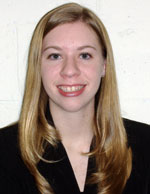 Meet Mary Irelan, University of Illinois student and about to become, AgWired blogger. Actually, she’ll just be blogging her experiences as a first time visitor to Commodity Classic next week. Her trip is being sponsored by
Meet Mary Irelan, University of Illinois student and about to become, AgWired blogger. Actually, she’ll just be blogging her experiences as a first time visitor to Commodity Classic next week. Her trip is being sponsored by 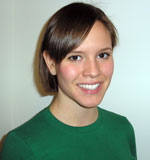 Meet Margy Fischer, University of Missouri student and also blogging her Commodity Classic experience right here on AgWired. Both Mary and Margy will begin blogging their trip next Tuesday. All their posts will be categorized by their name so you can easily find them, since they’ll be mixed in with my coverage of the event. Additionally, they’ll also be helping me with my coverage. I was very happy to find out that they will be bringing a digital camera and notebook computer. That’s what the ag journalist of the future must be equipped with.
Meet Margy Fischer, University of Missouri student and also blogging her Commodity Classic experience right here on AgWired. Both Mary and Margy will begin blogging their trip next Tuesday. All their posts will be categorized by their name so you can easily find them, since they’ll be mixed in with my coverage of the event. Additionally, they’ll also be helping me with my coverage. I was very happy to find out that they will be bringing a digital camera and notebook computer. That’s what the ag journalist of the future must be equipped with. I think Monsanto is one of the companies that’s “getting it.” They’re already
I think Monsanto is one of the companies that’s “getting it.” They’re already 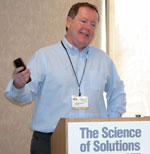 Our last session of the day involves a discussion on intellectual property rights and how they benefit society.
Our last session of the day involves a discussion on intellectual property rights and how they benefit society.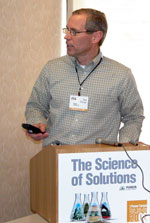 When we got to precision farming it was time for a tag team approach again. Getting this session started was Tom Doerge, Agronomy Research Scientist. Tom talked about using yield monitors and doing on-farm testing. He had some great photos of fields in which different treatments were applied side-by-side and in other patters. I will ask if these presentations are available.
When we got to precision farming it was time for a tag team approach again. Getting this session started was Tom Doerge, Agronomy Research Scientist. Tom talked about using yield monitors and doing on-farm testing. He had some great photos of fields in which different treatments were applied side-by-side and in other patters. I will ask if these presentations are available.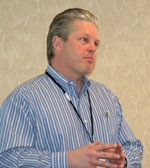 Tag team member Todd Prescott got into the services Pioneer offers its customers who want yield mapping done for them. A certain amount of this information is or can be available via internet and computer. So, I asked him what kind of feedback he gets from growers about internet access. I was surprised and pleased to hear him say that farmer access to broadband is growing fast. He sees a lot of DSL becoming available and throughout the corn belt and soybean growing areas of the country. In fact, he’s spoken with growers who now have high speed options. He’s been hearing growers say they’ll have it installed and working as soon as they can now that it’s available in their area.
Tag team member Todd Prescott got into the services Pioneer offers its customers who want yield mapping done for them. A certain amount of this information is or can be available via internet and computer. So, I asked him what kind of feedback he gets from growers about internet access. I was surprised and pleased to hear him say that farmer access to broadband is growing fast. He sees a lot of DSL becoming available and throughout the corn belt and soybean growing areas of the country. In fact, he’s spoken with growers who now have high speed options. He’s been hearing growers say they’ll have it installed and working as soon as they can now that it’s available in their area.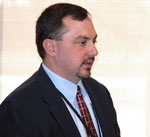 Jody did a great job and I hope he earned himself a Pioneer logo blazer!
Jody did a great job and I hope he earned himself a Pioneer logo blazer! I said there’s a lot of media here at the Pioneer event. I’m actually surprised that almost all of them have stayed through the whole event.
I said there’s a lot of media here at the Pioneer event. I’m actually surprised that almost all of them have stayed through the whole event.